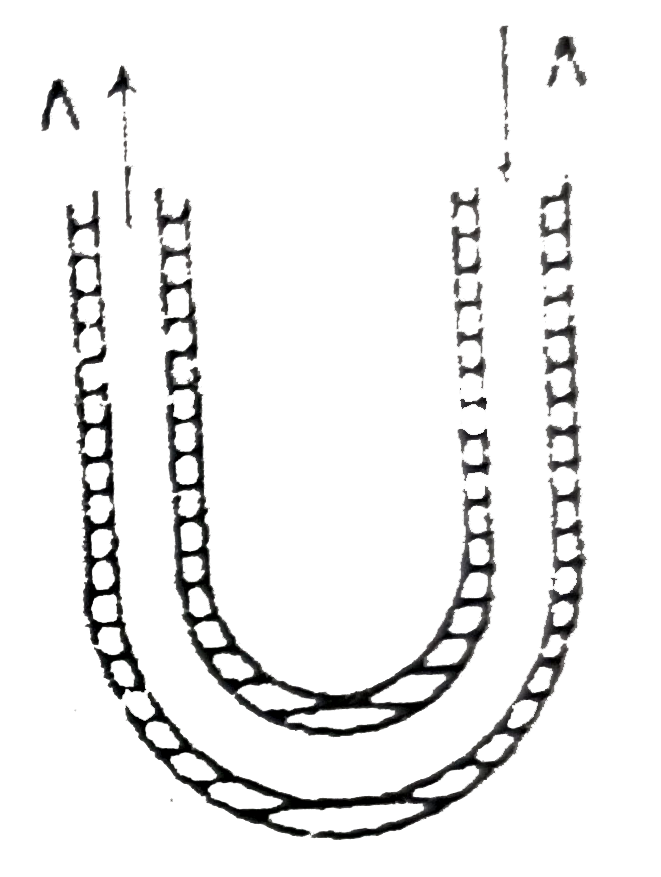A bob of mass 10 kg is attached to wire 0.3 m long. Its breaking stress is . The area of cross section of the wire is . The maximum angular velocity with which it can be rotated in a horizontal circle
The correct Answer is:4
To find the maximum angular velocity with which the bob can be rotated in a horizontal circle, we can follow these steps:
Step 1: Understand the relationship between stress, force, and area
The breaking stress (σ) of the wire is given by the formula:
σ=FA
where:
- F is the force acting on the wire,
- A is the area of cross-section of the wire.
Step 2: Calculate the maximum force the wire can withstand
Rearranging the formula for stress, we can express the maximum force (F_max) as:
Fmax=σmax×A
Substituting the given values:
- σmax=4.8×107N/m2
- A=10−6m2
Calculating Fmax:
Fmax=4.8×107×10−6=48N
Step 3: Relate the force to angular velocity
The force acting on the bob when it is rotating in a circle is given by:
F=m⋅r⋅ω2
where:
- m is the mass of the bob,
- r is the radius of the circle (which is equal to the length of the wire),
- ω is the angular velocity.
Step 4: Substitute the known values
Here, the mass m=10kg and the radius r=0.3m. We can substitute these into the force equation:
Fmax=m⋅r⋅ω2
Substituting the known values:
48=10⋅0.3⋅ω2
Step 5: Solve for angular velocity
Rearranging the equation to solve for ω2:
ω2=4810⋅0.3=483=16
Taking the square root to find ω:
ω=√16=4radians/second
Conclusion
The maximum angular velocity with which the bob can be rotated in a horizontal circle is:
ωmax=4radians/second
---
The breaking stress (σ) of the wire is given by the formula:
σ=FA
where:
- F is the force acting on the wire,
- A is the area of cross-section of the wire.
Rearranging the formula for stress, we can express the maximum force (F_max) as:
Fmax=σmax×A
Substituting the given values:
- σmax=4.8×107N/m2
- A=10−6m2
Fmax=4.8×107×10−6=48N
The force acting on the bob when it is rotating in a circle is given by:
F=m⋅r⋅ω2
where:
- m is the mass of the bob,
- r is the radius of the circle (which is equal to the length of the wire),
- ω is the angular velocity.
Here, the mass m=10kg and the radius r=0.3m. We can substitute these into the force equation:
Fmax=m⋅r⋅ω2
Substituting the known values:
48=10⋅0.3⋅ω2
Rearranging the equation to solve for ω2:
ω2=4810⋅0.3=483=16
Taking the square root to find ω:
ω=√16=4radians/second
The maximum angular velocity with which the bob can be rotated in a horizontal circle is:
ωmax=4radians/second
Topper's Solved these Questions
- PROPERTIES OF MATTERBook:VMC MODULES ENGLISHChapter:PROPERTIES OF MATTERExercise:Level -2
Explore 50 Videos
- PROPERTIES OF MATTERBook:VMC MODULES ENGLISHChapter:PROPERTIES OF MATTERExercise:JEE Main (Archive) Level - 1
Explore 48 Videos
- PROPERTIES OF MATTERBook:VMC MODULES ENGLISHChapter:PROPERTIES OF MATTERExercise:JEE Advanced (Archive) Level - 2 (MATRIX MATCH TYPE)
Explore 1 Video
- MOVING CHARGES & MAGNETISM Book:VMC MODULES ENGLISHChapter:MOVING CHARGES & MAGNETISM Exercise:IN-CHAPTER EXERCISE-K
Explore 10 Videos
- QUIZBook:VMC MODULES ENGLISHChapter:QUIZExercise:PHYSICS
Explore 30 Videos
Similar Questions
A bob of mass 10kg is attached to a wire 0.3m long. Its breaking stress is 4.8×107N/m2. Then area of cross-section of the wire is 10−6m2. What is the maximum angular velocity with which it can be rotated in a horizontal circle?
View SolutionThe breaking stress of steel is 7.85×108N/m2 and density of steel is 7.7×103kg/m3. The maximum frequency to which a string 1m long can be tuned is
View SolutionA mass of 20kg is attached to one end of a steel wire 50cm long and is rotated in a horizontal circle. The area of cross-section of the wrie is 10−6m2 and the breaking stress for it is 4.8×107Pa. Calculate the maximum velocity with which the mass can be rotated.
View SolutionA wire of length l = 3m and area of cross section 10−2cm2 and breaking stress 4.8×10−7Nm2 is attached with block of mass 10kg. Find the maximum possible value of angular velocity with which block can be moved in circle with string fixed at one end.
View SolutionA body of mass m = 10 kg is attached to a wire of length 0.3m. The maximum angular velocity with which it can be rotated in a horizontal circle is (Given, breaking stress of wire =4.8×107Nm−2 and area of cross-section of a wire =10−6m2)
View SolutionA lift of mass 1000 kg is suspended by steel wire of maximum safe stress 1.4×108N/m2. Find the minimum diameter of the wire, if the maximum acceleration of the lift is 1.2ms−2
View SolutionThe density of the material of a wire used in sonometer is 75×10−2kg/m3. If the stress on the wire is 3.0×104N/m2, the speed of transverse wave in the wire will be
View SolutionA uniform cylindrical wire is subjected to a longitudinal tensile stress of 5×107N/m2. Young's modulus of the material of the wire is 2×1011N/m2. The volume change in the wire is 0.02%. The factional change in the radius is
View SolutionA pipe of circular cross-section of inner radius r and outer radius 2r is bent into a semi circle as shown in the diagram. A fluid of density ρ=103kg/m3 is flowing through it. The breaking stress of the material of the pipe is 3×107n/m2. The maximum velocity with which the fluid can flow in the pipe is k×100m/s. find value of k.

View SolutionThe resistivity of a potentiometer wire is 40×10−8Ω−m and its area of cross section is 8×10−6m2. If 0.2 A current is flowing through the wire the potential gradient will be
View Solution